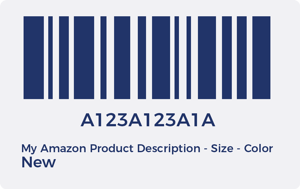Originally published on May 18, 2017, updated September 16, 2024
Menu
Join Our Email List
- Receive our monthly newsletter.
- Stay up to date on Amazon policies.
- Get tips to grow your business.
Getting used to all the acronyms on the Amazon marketplace can make you feel like you just joined the military. ASIN, UPC, SKU, and lots of other insider jargon get thrown around as if they are common knowledge for everyone.
It can be very confusing if you don't know the difference between these codes. Many sellers don't know a lot of the nuances.
Here's a quick primer on each of the major terms you need to know and how they are different. After reading this guide, you'll understand the differences between ASIN vs ISBN, SKU vs GTIN, and much more!
The most important term to know as a seller on the Amazon marketplace is ASIN. But what is the ASIN number, and why is it so important? It stands for Amazon Standard Identification Number. It's how all products are internally cataloged, indexed, and tracked on the Amazon marketplace. The most prominent place you see the ASIN is on the URL of the product page.
As Amazon started out mostly selling books, the ASIN is very similar to the ISBN (the standard number for books – more on that later). Both are 10 digits, and in the case of most books, the ISBN is the ASIN. However, for other products, the ASIN might be numbers and letters. A new ASIN is created when an item is uploaded into the Amazon catalog.
 If you do a lot of international selling, you may notice that an ASIN might direct you to a different page for different regions. For example, the same ASIN for a pair of shoes could send viewers to one page on the Amazon US marketplace and another page on the German marketplace.
If you do a lot of international selling, you may notice that an ASIN might direct you to a different page for different regions. For example, the same ASIN for a pair of shoes could send viewers to one page on the Amazon US marketplace and another page on the German marketplace.
When registering a new ASIN, it must be linked to something outside of the Amazon ecosystem. For example, books are linked to the ISBN number. There are several of these systems called Global Trade Item Numbers (GTIN). These are the numbers you see next to the bar code on the packaging of items. Let's look at the most popular ones and how they differ.

ISBN stands for International Standard Book Number. It was originally 10 digits, but after January 1, 2007, ISBNs were elongated to 13 digits to align better with the EAN (more on that below). A different ISBN is given to each edition of a book. For example, the paperback and hardback versions of a book will have different ISBNs. Similarly, the 2017 edition and the 2014 edition will have different ISBNs.
As mentioned above, an item's ASIN and ISBN are generally always the same number.
UPC stands for Universal Product Code. This is the standard system in the United States for assigning a product code for each retail item sold. It is also the most common GTIN in the States. The UPC is 12 digits and is usually found underneath or on top of the bar code, sometimes with numbers off to the sides. Just like books, any change or variation in the product means a different UPC.
Understanding Amazon terminology can be tough — learn more about common Amazon terms and see an Amazon abbreviation list in our Amazon Seller Glossary.
EAN stands for European Article Number. As you guessed, this is the GTIN system used mostly in Europe, but also in other regions. The EAN functions just like the UPC, except that the EAN is 13 digits. As mentioned earlier, ISBNs have converted to a 13-number format to align with the EAN. 12-digit UPCs are often prefixed with a 0 to create a 13-digit EAN.
The GTIN-14 stands for Global Trade Item Number. Unlike the other GTINs, this one is 14 digits long. It is reserved only for wholesale items, not retail, so it is not usually used when first registering an ASIN unless you have a special situation selling bulk items. You typically find the GTIN-14 on the outside of a shipping container.
SKU stands for Stock Keeping Unit. The SKU is NOT a GTIN and can't be used when first registering a product on the Amazon marketplace. The SKU is an internal number restricted only to your business or a supplier's catalog. It's a way to keep track of your inventory and what items are coming and going.
Many businesses will use the GTIN (UPC, ISBN, EAN) as their SKU, but they don't have to. For example, some companies may use a numbering system for their SKU that helps them know where the item is located in the warehouse. For this reason, the SKU is meaningless to most people outside of a company. It isn't regulated or standardized.
The vendor you buy from might use an SKU different from the GTIN. For your own record keeping, you can use the same SKU the vendor uses, your own custom SKU, or the GTIN. However, when registering a product on the Amazon marketplace, you must use the GTIN.
Most developed out of different industries and regions and slowly came together. Now, major GTINs like the UPC, ISBN, and EAN are all standardized under the, wait for it, GS1 system (yep, another acronym).
Do a single pack of socks and a three-pack of socks have different GTINs and ASINs? You bet.
When listing items on the Amazon marketplace, you must make sure that you have selected the right GTIN that matches the size of the pack that you want to sell.
Bundles and kits (multiple items that are grouped together) must also have different GTINs. All bundles must follow the bundle guidelines and are subject to review for accuracy and relevance and may be removed without notice.
If you are selling an entire manufacturer case pack, you should use the GTIN-14, not the UPC for any single item contained in the case. The GTIN-14 identifies a case pack that can be sold as a unit.
If you are making your own custom products, or are creating new packs, bundles, or kits that don't yet exist, you'll need to apply to get a GTIN for those items before you can sell them on the Amazon marketplace. Follow these instructions to start the process. You can license GTINs through GS1 US through eComEngine! We're proud to be a GS1 US Channel Partner.
As confusing as it might be, GTINs and ASINs are very important for sellers on the Amazon marketplace and you are wise to educate yourself. Once you've cracked the acronym code you can spend time focusing on more important things, like building your brand!
Originally published on May 18, 2017, updated September 16, 2024
This post is accurate as of the date of publication. Some features and information may have changed due to product updates or Amazon policy changes.
These Stories on Amazon
14321 Winter Breeze Drive
Suite 121 Midlothian, VA 23113
Call us: 800-757-6840





Copyright© 2007-2025 eComEngine, LLC. All Rights Reserved. eComEngine®, FeedbackFive®, RestockPro®, and SellerPulse® are trademarks or registered trademarks of eComEngine, LLC. Amazon's trademark is used under license from Amazon.com, Inc. or its affiliates.
No Comments Yet
Let us know what you think